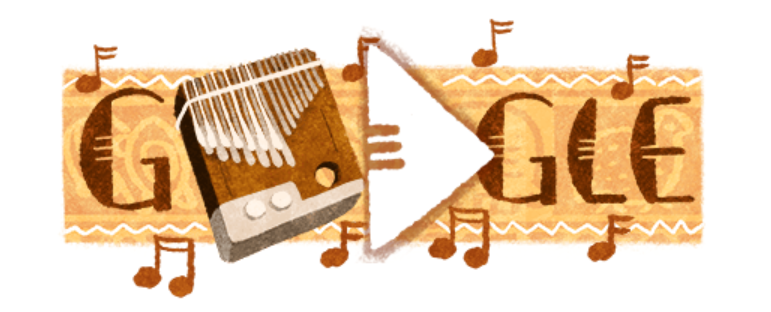A few days ago, Google gave its homepage a temporary logo that blew me away: This one had an earth-toned drawing of an ancient musical instrument called the mbira.
Not your basic “thumb piano”: mbira photo by Alex Weeks, Wikimedia Commons.
Outside of Africa, few people have heard of the mbira (“em-BEE-ra”). Those do often get hooked.
Last year, the American duo Pomplamoose featured a giant mbira in a breathtaking cover of the Billie Eilish song “Bury a Friend.”
I’ve been learning to play this meditative instrument for a few years now. It has a tinkling sound, like falling rain.
The mbira is made from metal keys, longer than spoon handles, fastened to a wooden slab the size of an iPad. Bottle caps give it a buzzing sound.
Caution Shonhai: mbira player and healer, February, 2019.
You need sturdy thumbs and solid rhythm to learn the intricate patterns of a traditional mbira song. The Shona people of Zimbabwe have been playing interlocking melodies on this instrument for more than 1,000 years.
Google’s Doodle nod to the mbira has Zimbabweans rejoicing worldwide. (Not all, though: some Zimbabwean scholars are calling Google’s project a form of “cultural vampirism.”)
Nevertheless, I’m glad to see people in high-tech places paying attention to other kinds of ingenuity.
I got to know the mbira better last year on a family trip to Zimbabwe. We landed in the capital city, Harare, and then made our way to the rural village of Ubuntu, named for the African philosophy that translates as “I am, because we are.”
We spent a few days hanging out with children bathed in mbira music since before they were born, along with musicians who filled us in on its fundamental role in Shona communities.
The Shona regard the mbira as a sacred instrument—a way to connect with ancestors long past. Several musicians described it to me as a “cell phone to the spirit world.”
Mbira party at Ubuntu village, 2019. From left: Joyce Warikandwa, Dzekwa Samaita, Chiedza Mutamba.
Google’s mbira Doodle barely touched on Shona spirituality (a respectful choice for a topic far too complex to cover in a brief video).
Art by Google “doodler” Helene Leroux.
Instead, the “doodlers” did a nice job of capturing the joy the mbira brings to those who hear and play it. The Google animations tell the story of a girl who learns to play the mbira at a young age and later inspires the next generation.
“We’ve tried to give people around the world a taste of a broad and deep cultural tradition that isn’t very well known outside its homeland,” said Jonathan Schneier, the Google software engineer who pitched the idea.
Schneier knew of similar instruments through his family in South Africa. Lots of people have heard of African “thumb pianos,” he said, but “I was curious, what are the origins, where did this come from?” He and his Google teammates followed the trail all the way to Zimbabwe.
They definitely did their homework. When I clicked on the “behind the scenes” video (at the bottom of this post), I recognized many names in their list of Zimbabwean consultants:
Fradreck Mujuru (centre) teaching in Berkeley, California. (I’m on the right, in red.)
There was Fradreck Mujuru, descendant of a long line of mbira players (and maker of the sweet-toned mbira I play). He has traveled to America multiple times to perform and teach in cities such as Berkeley.
Other familiar faces included Musekiwa Chingodza, a top mbira player, and Caution Shonhai, a musician and teacher I met in Zimbabwe.
Shonhai doubles as a healer in his village. Listening to the mbira calms the brain, he told me. This line of thinking is consistent with medical research on music as a treatment for acute anxiety. (I’ll be exploring the connection between music and health in my book.)
But the best reason to get into mbira music, of course, is pleasure.
“I think anyone who has had more than five minutes with the Zimbabwean mbira cannot forget the sound,” said Albert Chimedza, founder of the Mbira Centre in Harare, speaking on the Google video.
“To me, it’s a cross between water and air.”
learn more:
The non-profit MBIRA organization supports traditional Shona music through the sale of musical recordings, instructional media, and mbira instruments made by master craftspeople in Zimbabwe. MBIRA was founded by Erica Azim, who in 1974 became one of the first non-Zimbabweans to study the instrument with traditional mbira masters. She has taught mbira players worldwide. (I have taken several workshops with Erica, and can vouch for her gifts.)










